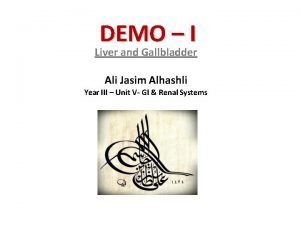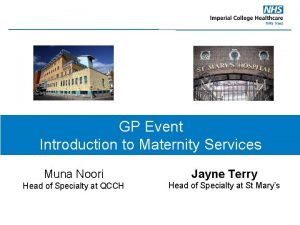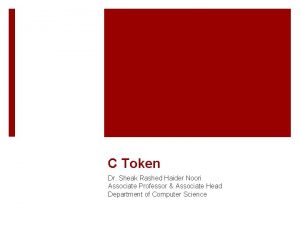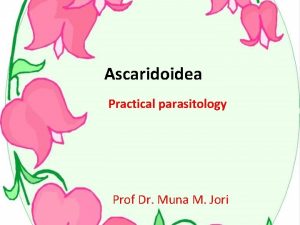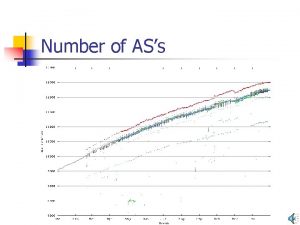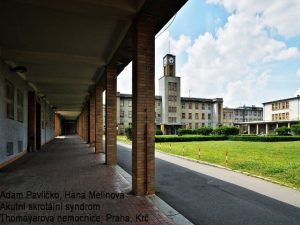Dr Noori Hannon Jasim Ass Professor and Consultant














- Slides: 14

Dr Noori Hannon Jasim Ass. Professor and Consultant surgeon/ General &GI Surgery FICS, Ph. D GI Surgery (United Kingdom)

Largest gland in the body 1. 5 kg The liver is completely surrounded by a fibrous capsule but only partially covered by peritoneum -Functions: 1. Production and secretion of bilirubin (bile pigment & salts) 2. Involvement in many metabolic activities related to CHO, Fat, protein, hormones and drugs 3. Filtration of blood from bacteria and foreign particles. 4. Maintaining core body temperature and PH balance. Liver Function Test (LFT) Billirubin, Alk phosphatase, Aspartate transaminase (AST), Alanine T. (ALT), Gamma-glutamyl transpeptidase (GGT), Alb, PT

Liver Anatomy _Liver lobes Right, left, caudate & quadrate -porta hepatis (liver hilum) -Peritoneal ligs of the liver -falciform ligament -lesser omentum -Blood &nerve supply -lymphatic & venous drainage -The liver lobules

The Internal anatomy of the liver Liver segments(I-VIII) Segment (I-IV) to the Lt of line between gall b. fossa (L portal v, L hep a, L h. v& M h. v. ) Segment (V-VIII) to the r of line between gall bladder (R portal v, R hep a, R h. v and M h. v. )

Questions What is the contents of porta hepatis? Surgical benefits Why we needs to know liver segments? which anatomical facts leads to this classification

Imaging of the liver 1. Ultrasound Scan first line test safety & availability; Detect bile duct dilatation, gall stones, liver tumours, liver cyst & guiding the P/C liver biopsy.

2. CT Scan…. Triple phase spiral CT: A. Oral Contrast CT enhancement. . Visualization of the stomach & duodenum in relation to the liver hilum. B. IV contrast 1 -Early arterial phase …detecting small liver tumours 2 -venous phase …. Inflammatory lesions exhibit rim enhancement 3 -Late venous enhancement… haemangioma 4 -Measurement of density of liver lesion (cystic) -

3. MRI; Indications: A. When IV contrast CT is contraindicated because of allergy B. MRCP excellent quality imaging of the biliary tract non-invasively. ERCP or PTC pictures are better than MRCP ones. C. MRA: hepatic a, portal v without the need for arterial cannulation. It is used as an alternative to hepatic angiography

4. ERCP: Indications: A. Diagnostic as in: 1. Obstructive jaundice or 2. previous imaging suggesting biliary tract abnormality B. Therapeutic: 1. Stone retrieval, 2. ballon dilatation of strictures 3. Stent insertion 4. brush cytology of tumors for cytology

Pre operative preparation: A. Check the coagulation B. Prophylactic AB C. Explanation of possible complications such as pancreatitis , cholangitis, bleeding and perforation related to sphinectrotomy. Endoluminal Ultrasound: …provide additional information on the extent of hilar tumours. PTC Indications: 1. When ERCP has failed or impossible 2. Hilar bile duct tumour where ERCP failed to visualize the intrahepatic bile ducts Angiography: Indications: 1. Diagnostic such as A. to visualize the anatomy of the hepatic artery, confirm the patency of portal v. B. additional information of a liver nodule. 2. Therapeutic such as A. occlusion of AV malformations and B. embolization of bleeding sites in the liver C. Chemoembolization

Nuclear Medicine Scanning A. Technetium-99 m (99 m TC)-labeled radionuclide: IV circulation Liver (hepatocytes) bile Gamma camera Dx bile leak and biliary obstruction. B. Sulphur colloid liver scan Uptake by Kuppfer cell differentiate adenoma & haemangiomas (no uptake) Vs. Focal Nodular Hyperplasia (FNH) (uptake) Laparoscopy & Laparoscopic Ultrasound It is useful for the staging of HBP Cancers, peritoneal metastases and superficial liver tumours.

Questions True or False CT is better than MRCP in detection of biliary tree pathologies MRCP is invasive theraputic tech. while ERCP is noninvasive and only diagnostic 3. Ultrasound scan not diagnose liver cyst 4. PTC liver test is an IV injection of dye when it fails then ERCP is second choice. 5. pancreatitis , cholangitis, bleeding and perforation are main complications of MRCP 1. 2.

Liver Trauma ; Serious injuries, A. Penetrating (stab or gunshot) contusion, laceration and avulsion of the liver B. Blunt Diagnosis: A. High suspicion of all lower chest and upper abd. stab wounds (penetrating) or crushing (blunt) injuries +(haemodynamically unstable. . PR increase, BP decrease, +++ needs blood transfusion) B. Blunt +haemodynamically stable + tenderness & guarding 1. U/S then iv enhanced CT scan of the chest and abd 2. Chest scan …lung parenchyma or big vessel damage 3. peritoneal lavage & diagnostic aspirate showing free fluid and haemoperitonium 4. Laparoscopy …any associated diaphragmatic rupture.

Treatment: Penetrating : A. Resuscitation ABC Airway, breathing & circulation Cannula, blood preparation, Volume replacement (colloid, O-ve blood), Chest tube once indicated B. then transferred to operating theatre for Exploratory laparotomy Blunt: 1. Sever blunt trauma same plan of A. resuscitation B. Theatre and as above (penetrating) 2. Mild blunt trauma &/or haemodynamically stable Imaging as mentioned in previous slide and then accordingly Indications to stop conservative treatment: 1. Ongoing blood loss in spite of correction of any underlying coagulopathy, 2. Development of signs of generalized peritonitis Complications: 1. sudden massive blood loss 2. subcapsular or intracapsular hematomas 3. liver abscess 4. biliary fistulae (rare) 4. Hep. artery. aneurysms , A/V& arteriobiliary fistulae. 5. Occasionally liver failure in extensive trauma 6. long term Cx rare like biliary tract stricture
